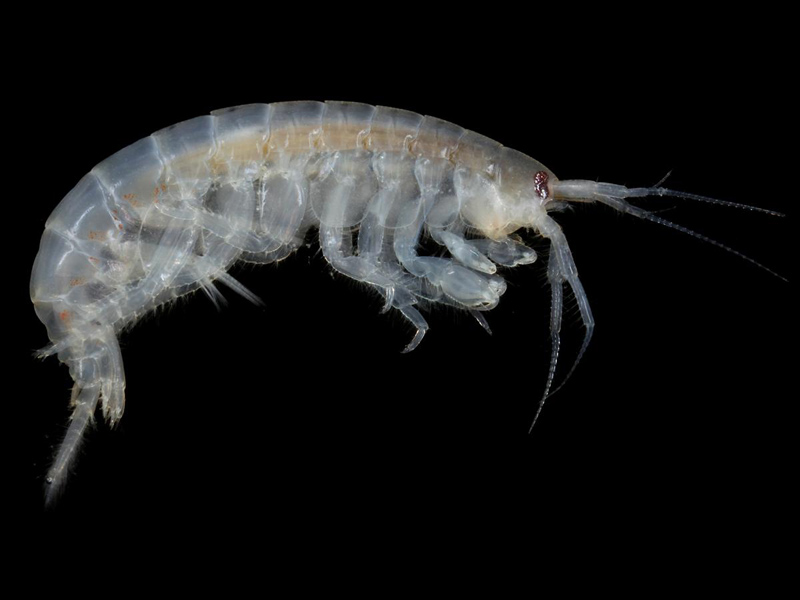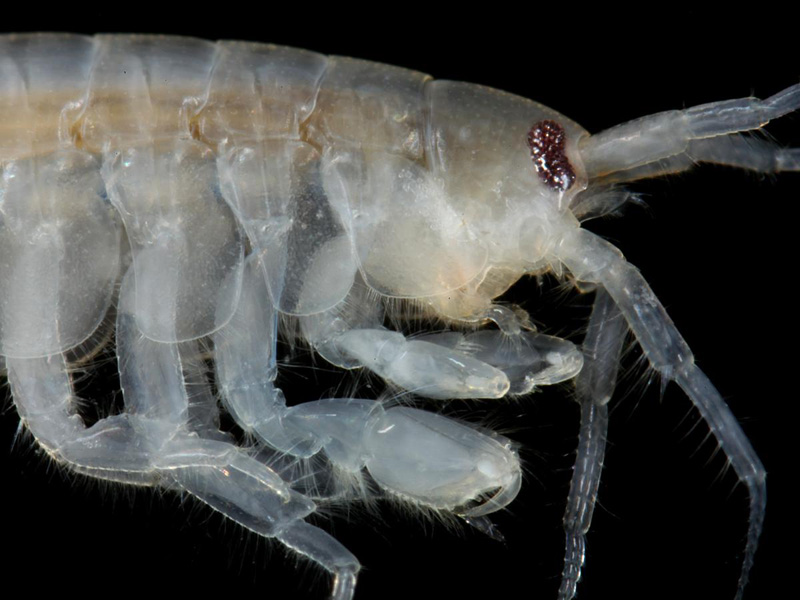A sand hopper (Echinogammarus incertae sedis planicrurus)
Distribution data supplied by the Ocean Biodiversity Information System (OBIS). To interrogate UK data visit the NBN Atlas.Map Help
| Researched by | Susie Ballerstedt & Georgina Budd | Refereed by | Admin |
| Authority | (Reid, 1940) | ||
| Other common names | - | Synonyms | Echinogammarus planicrurus , Echinogammarus planicrurus , Pectenogammarus planicrurus |
Summary
Description
Recorded distribution in Britain and Ireland
Recorded from several sites around southern Britain and Ireland. However, lack of records is probably due to lack of survey effort (Bell, 1995) and Pectenogammarus planicrurus may have a significantly wider range than records suggest.Global distribution
Found along the Atlantic coast of Europe to the Mediterranean (Kant et al., 1968; Maren, 1975, 1975b; Stock, 1973, 1982).Habitat
Found in the intertidal on clean shingle beaches, especially in the lee of obstacles such as rocks and groynes. It is the only amphipod that is a permanent resident of shingle habitats.Depth range
-Identifying features
- Dorso-ventrally flattened body.
- Two pairs of antennae, the second pair have a thicker fringe of hairs than the first.
- Body is white with no markings.
- Body length up to about 9 mm in males, to about 5 mm in females.
- The male is particularly distinct owing to the dense fringes of hair over its body.
- Large, elongated, kidney-shaped eyes.
- Found on shingle beaches.
Additional information
Echinogammarus incertae sedis planicrurus may be confused with species of the genus Chaetogammarus and Echinogammarus. The species can be distinguished by the spines on the palps and shape of mouth parts (see Lincoln, 1979).Listed by
- none -
Bibliography
Bell, M.C. & Fish, J.D., 1996. Fecundity and seasonal changes in reproductive output of females of the gravel beach amphipod Pectenogammarus planicrurus. Journal of the Marine Biological Association of the United Kingdom, 76, 37-55.
Bell, M.C., 1995. Pectenogammarus planicrurus - there is life in gravel beaches. Porcupine Newsletter, 6, 41-47.
Duhig, M. & Humphries, C., 1955. Amphilochus brunneus Della Valle, an amphipod new to Britain and Ireland and notes on other amphipods not previously recorded in Irish coastal waters, Proceedings of the Royal Irish Academy (B), 57, 123-129.
Duhig, M., 1960. The Amphipoda of Dalkey Island and its neighbouring waters. Proceedings of the Royal Irish Academy (B), 61, 59-77.
Fish, J.D. & Fish, S., 1996. A student's guide to the seashore. Cambridge: Cambridge University Press.
Howson, C.M. & Picton, B.E., 1997. The species directory of the marine fauna and flora of the British Isles and surrounding seas. Belfast: Ulster Museum. [Ulster Museum publication, no. 276.]
JNCC (Joint Nature Conservation Committee), 1999. Marine Environment Resource Mapping And Information Database (MERMAID): Marine Nature Conservation Review Survey Database. [on-line] http://www.jncc.gov.uk/mermaid
Kant, P., Pinkster, S. & Stock, J.H., 1968. Sur la présence, en Méditerranèe, de Pectenogammarus planicrurus Reid, 1940. Vie et Milieu, 19, 206-209.
Lincoln, R.J., 1979. British Marine Amphipoda: Gammaridea. London: British Museum (Natural History).
Morgan, E., 1970. The effect of environmental factors on the distribution of the amphipod Pectenogammarus planicrurus, with particular reference to grain size. Journal of the Marine Biological Association of the United Kingdom, 50, 769-785.
Reid, D.M., 1940. On Gammarus (Pectenogammarus) planicrurus subgen, et sp., n., Annals and Magazine of Natural History (Series II), 6, 287.
Reid, D.M., 1944. Gammaridae (Amphipoda); with key to the families of British Gammaridea. Synopses of British Fauna, 3, 1-33.
Sanderson, W.G., 1996. Rare benthic marine flora and fauna in Great Britain: the development of criteria for assessment. Joint Nature Conservation Committee, Peterborough. JNCC Report, no. 240.
Stock, J.H., 1973. The existence of interstitial members of the Gammarus-group (Amphipoda). Crustaceana, 24, 339-341.
Stock, J.H., 1982. Validité du genre Pectenogammarus Reid, 1940 et distribution de son espèce-type, P. planicrurus (Reid, 1940) (Crustacea, Amphipoda, Gammaridae). Cahiers de Biologie Marine, 23, 325-329.
Van Maren, M.J., 1975. Some notes on the intertidal gammarids (Crustacea, Amphipoda) from the Atlantic coast of the Iberian peninsula. Beaufortia, 23, 153-168.
Van Maren, M.J., 1975b. The biology of Chaetogammarus marinus (Leach) and Eulimnogammarus obtusatus (Dahl) with some notes on other intertidal gammarid species (Crustacea, Amphipoda). Bijdraen tot de Dierkunde, 45, 205-224.
Datasets
Manx Biological Recording Partnership, 2017. Isle of Man wildlife records from 01/01/2000 to 13/02/2017. Occurrence dataset: https://doi.org/10.15468/mopwow accessed via GBIF.org on 2018-10-01.
NBN (National Biodiversity Network) Atlas. Available from: https://www.nbnatlas.org.
OBIS (Ocean Biodiversity Information System), 2024. Global map of species distribution using gridded data. Available from: Ocean Biogeographic Information System. www.iobis.org. Accessed: 2024-04-25
Citation
This review can be cited as:
Last Updated: 03/07/2006





